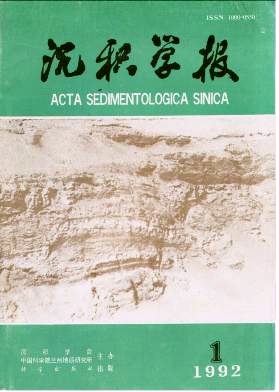The Distribution of K and Ar in Sedimentary Rock and the Ar Isotope of Natural Gas From Some Oit-gas-bearing Basins in China
- Received Date: 1990-06-01
- Publish Date: 1992-03-10
Abstract: The K and Ar contents and apparent ages of 41 core samples of different depth, time and lithology from oil-gas bearing basins of Bohaiwan, Sichuan and Ordos have been analysed and determined, and the clay minerals of 26 samples from the basins have also been analysed.The distributive characteristics of K and Ar contents in the different districts and time as well as the relationship between K-contents and illite contents of clay minerals in mudrocks have been studied.The distributions of K, Ar contents for mudrocks and carbonate rocks have contrastively been studied.The relationship between of Ar isotopic in sedimentary rocks and natural gases has been studied, too.The results show that: ①The apparent ages is higher than geological ages in younger rocks, but lower in older rocks. ② As contrasted to mudrock, the K and Ar contents are lower in the carbonate rock in the same period. ③The Ar(air)of sedimentary rocks mainly comes from the atmosphere argon which dissolved in sedimentary water and adsorped on fragments. There is a trend of decrease of Ar(air)with the development of diagenesis and the lapse of time. ④ As affected by the evolution of crust, diagenises and tectonics, the K-content contribution is cyclically chracterized, increase from Z to O, and decrease from O to P, than increase from P to J, and reduce since then.The whole evolution above is meiinly divided into two cycles which indicate the active and stable evolution of crust respectively. ⑤Plenty of illite widespreads m mudrocks and there is a good relation between the K -content of mudrocks and illte content of clay mineials. which shows that the K element in mudrock occupied laltices of illite The d art bution of 40 Ar is controlled by geological period lithology, and particularly depends upon the loss dearee of Ar diffusion from rocks and The remanent degree of Ar in detrilal minerals 40Ar in carbonate rock la ecly diffused. By comparison with theoretical value, losted 40 Ar m mudrocks is about 70-90% in pre-Pz. md about 40% in some of Pz 40Ar remained in sediments is about 80 -90% in Kz and about 40 60% in M/ and less than 50% in Pz The lower concentration of 40Ar in pre-Pz resulted from the long pe iod diffusion, but that in Pz-Mz is due to the Ar migration from source rock with natural gas. The h ther 40Ar content in Kz mainly remained in detrital mineral According to the geochemieal and geological data, the following conclusions can be drawn (1) A m sedimentary rocks have three origins the radiogenic Ar trapped in sedimertary detritai minerals, atmos-phere Ar dissolved m sedimertary water then included and adsorpted in the rock and radiogenic Ar m autogeruc K-bearing minerals, (2) Owing to widely existing illites included K-element in the mudroess, the source rocks could contribute 40Ar to natural gases. ( 3) Argon m natural gas enginated radiogemc and atmospheric argon in strata. (4) Argon migrated io gas reverviors by two stepps diffusion or crystal body changed and broken takes the 40Ar out of the crystal skeleton. Desorption atlmosphere argon from rocks surface.Second, both 40Ar and Ar (air) of first migritom graduilly ports by surmounted static water pressure and block condition with water and other getses dioxide, hydrocarbony, nitrogen and others), The velocity of the latter migrtion taster than he former, therefore the contenl of argon is natural gas is in close relationship with The argon of the first m That is the reason why Ihe argon isotopic composition of natural gas reflects the 40Ar chronolsical cumulation effect in the gas source rocks
| Citation: | Liu Wenhui, Xu Yongchang. The Distribution of K and Ar in Sedimentary Rock and the Ar Isotope of Natural Gas From Some Oit-gas-bearing Basins in China[J]. Acta Sedimentologica Sinica, 1992, 10(1): 83-92. |






 DownLoad:
DownLoad: